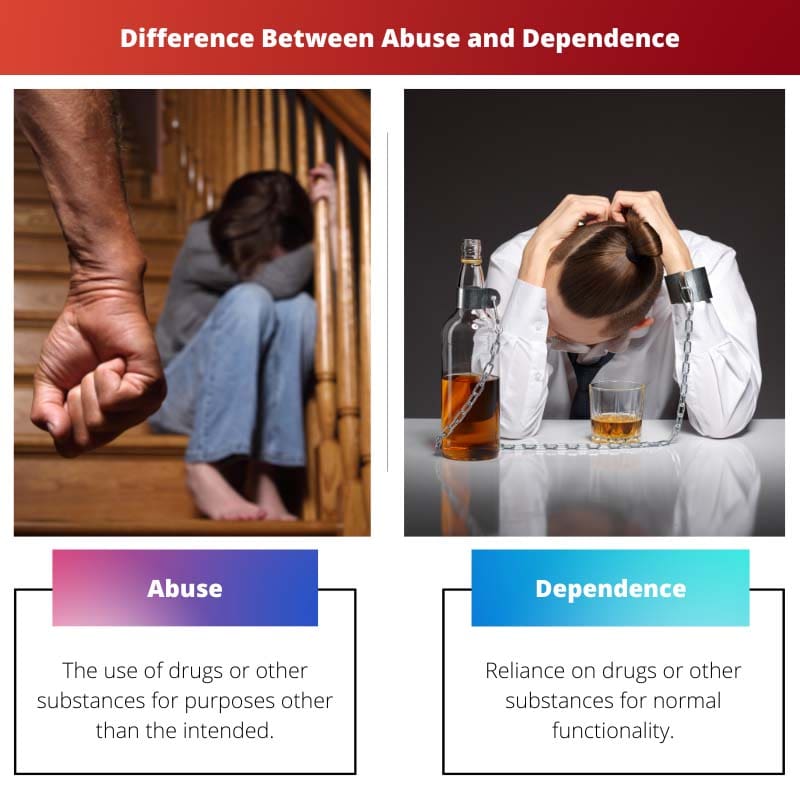Abuse and dependence are terms that are used identically. They are used in defining drug abuse and its various related stages. Both abuse and dependence have severe repercussions in personal and public life.
Substance abuse and dependence can become life-threatening. Substance abuse leads the user to mental and physical support and addiction.
People can overcome both these stages. The APA removed these terms and placed “substance use disorder” to refer to these conditions.
Key Takeaways
- Substance abuse involves the harmful or hazardous use of substances, such as drugs or alcohol, while dependence is a physical or psychological reliance on a substance.
- Abuse can lead to dependence, but not everyone who abuses substances will become dependent.
- Treatment for abuse focuses on reducing harmful behaviors, whereas treatment for dependence addresses the underlying addiction and may include medical intervention.
Abuse vs Dependence
The difference between abuse and dependence is that abuse is the unfair or improper use of any substance like drugs or alcohol. In contrast, dependence is the continuous reliability of those substances to avoid withdrawal symptoms or to satisfy the triggers. Both these conditions can become hazardous.

Abuse is a condition where an individual uses a drug or any other substance to attain a benefit. Substance abuse is primarily illegal. It is the first stage of drug usage.
The repeated use of substances builds tolerance. It is after these two conditions that a person goes into dependence. Abuse leads to addiction. Initial abuse is driven by peer pressure, experimentation, or other reasons.
Dependence is the condition where substance use is set as a mandatory rule for the sustenance of the individual. It is more severe than abuse and is close to addiction.
One can stay dependent on the substance without being addicted. It is a response to a drug. It involves signs of addiction. In this phase, the individual develops high tolerance for the pharmaceutical and craves more amount to get the initial experience.
Comparison Table
| Parameters of Comparison | Abuse | Dependence |
|---|---|---|
| Definition | The use of drugs or other substances for purposes other than the intended | Behaviour |
| Proximity to addiction | Far | Close |
| Levels of consumption | Low | High |
| Symptoms of withdrawal | Absent | Present |
| Behavior | Acts normally | Abnormal |
What is Abuse?
Abuse can exist in many forms. It is the mistreatment of anything for benefit. It may involve crime, unfair actions, or violation.
Substance abuse is the wrong usage of drugs for individual satisfaction or gain. The drug’s intended purpose is to avoid and is illegally used in substance abuse.
It can lead to disabilities, ineffectiveness, lack of control, and unhealthy behaviour. Some standard drug abuse practices involve consuming too much alcohol, misusing prescriptions, or using illegal drugs.
Substance abuse gives a sense of euphoria. Of that feeling, users tend to continue its usage leading to addiction. It can ruin an individual and society as well.
Common indications of substance abuse are a sudden change in behavioural patterns, lack of appetite, mood fluctuations, unhealthy skin, lack of hygiene, etc.
People who abuse drugs have anti-social behaviour. The intensity of damage varies with different medications.
Using the signs and symptoms of substance abuse, one can identify such people and intervene in them for treatment. At the level of substance abuse, it can be cured.
The abuse treatment is on various levels. The psychological level involves therapy, behavioural analysis, and social skills training. Medication is also a treatment option for substance abuse.

What is Dependence?
The reliance on a substance to satisfy the trigger to use can be termed dependence. It can lead to addiction.
When an individual continues to abuse a particular substance for a long, they develop a tolerance to it. So, to attain the “high,” they have to increase their consumption levels. This is called tolerance.
Dependence comes after the level of tolerance. Once a person reaches the tolerance level, they start feeling withdrawal symptoms. To retain their everyday bodily existence, the individual will continue consuming the substance.
Sometimes people who take a medicine for a long time can develop dependence. People in the phase of support consume drugs to ignore the discomfort of withdrawal. When an individual consumes a substance repeatedly, they get into addiction.
Various factors determine the development of drug dependence, like the substance, mode of consumption, and time. Brain structures like the nucleus accumbens implicate the psychological dependence on drugs.
The variations in gene expressions fluctuate dopamine levels. Thus, an individual is triggered to take more substance to reach the “high.” It creates the sensation of withdrawal, and eventually, physical dependence happens.

Main Differences Between Abuse and Dependence
- Drug dependence involves bouts of withdrawal and tolerance, while abuse enables tolerance and withdrawal.
- Abuse is the earliest stage of addiction, while dependence lies near addiction.
- There are clear indications of the perils of drug usage in the condition of abuse. But it is absent in dependence as the substance controls the individual.
- People who abuse substances can hide their intoxication symptoms by acting normal. But people who are dependent exhibit retardation in almost all aspects of life.
- Abuse is mostly episodic and doesn’t show withdrawal signs. While dependent people show withdrawal symptoms.
- Abusers are not routine users, while dependent people use the substance routinely to avoid withdrawal symptoms.

- https://digitalcommons.fiu.edu/srhreports/health/health/32/
- https://onlinelibrary.wiley.com/doi/abs/10.1111/j.1360-0443.2009.02596.x